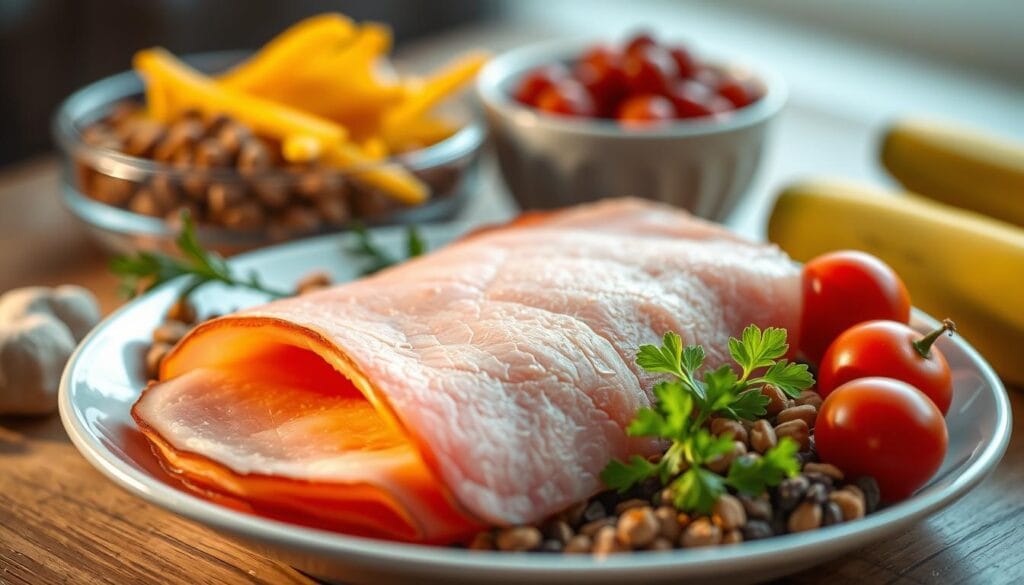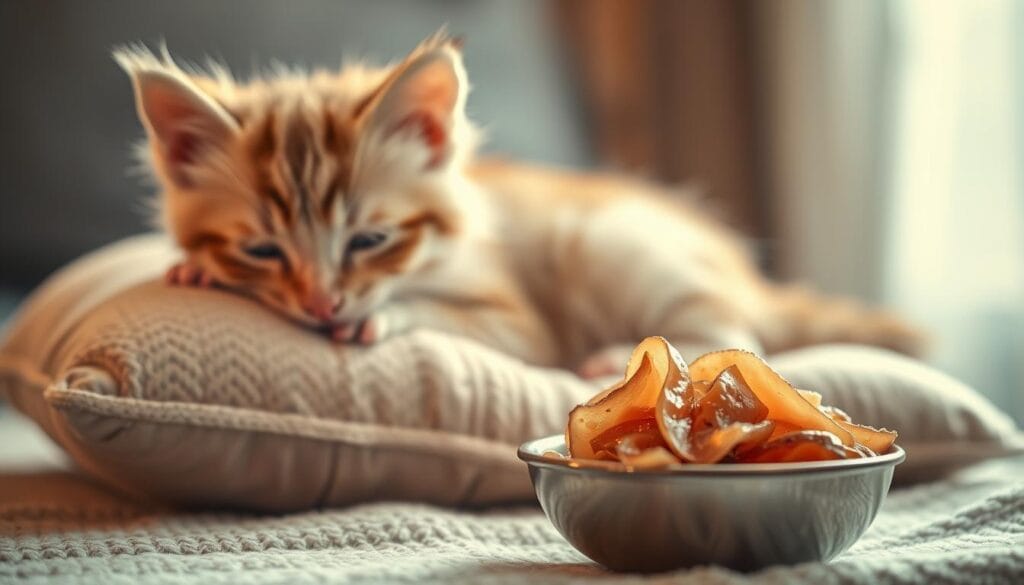Can Cats Have Ham? Safe Feeding Guide for Pet Parents
Sharing holiday meals with our furry companions feels natural. Those pleading eyes staring at your plate during family dinners? Every pet parent knows the struggle. But when it comes to protein-rich foods like ham, the answer isn’t as simple as it seems.
Table of Contents
Felines thrive on meat-based diets, needing essential nutrients found in animal products. Ham offers lean protein, which aligns with their biological needs. However, processed varieties often contain harmful additives like sodium or preservatives.
Pet owners often wonder if festive favorites pose hidden risks. While cooked, unseasoned slices might seem harmless, portion control matters. Even small amounts could lead to digestive upset or long-term health issues.
This guide breaks down the science behind feline nutrition and ham consumption. Learn how to balance occasional treats with your companion’s well-being. Discover why preparation methods and ingredient quality make all the difference.
Understanding Ham as a Feline Treat
Feline fascination with ham stems from evolutionary instincts. Carnivorous biology drives their preference for meat-based foods, particularly those rich in amino acids. While this protein source seems ideal, not all varieties align with nutritional needs.
What Makes Ham Appealing to Cats
The strong aroma of cured pork activates primal hunting responses. Lean cuts provide essential nutrients like taurine, which supports heart health and vision. This matches the dietary patterns of wild ancestors who consumed prey with similar nutritional profiles.
Common Misconceptions About Feeding Ham
Many assume all meat products automatically benefit carnivores. Processed deli slices often contain garlic powder or onion seasoning – ingredients toxic to felines. Sodium levels in commercial varieties also exceed safe limits, risking dehydration or kidney strain.
Fresh, unseasoned pork offers better nutritional value than store-bought alternatives. However, even high-quality cuts shouldn’t replace balanced meals. Moderation remains critical when introducing new proteins to a kitty’s diet.
Nutritional Benefits and Risks of Ham for Cats
Balancing dietary benefits with potential hazards requires understanding ham’s dual nature. While this meat offers nutritional value, its preparation methods dramatically influence safety for feline companions.

Protein and Essential Nutrients
Ham contains high-quality protein vital for tissue repair and energy production. Amino acids like taurine support heart function and vision, mirroring nutrients found in prey animals. Iron and B-vitamins aid oxygen transport and metabolic processes when consumed sparingly.
High Sodium and Fat Concerns
Processed varieties often contain sodium levels exceeding safe limits. Excessive salt intake strains kidneys and may cause hypertension. Fat content in cured meats increases pancreatitis risks – a severe pancreatic inflammation requiring urgent veterinary care.
Even reduced-sodium options still surpass recommended daily limits. Lean, unseasoned cuts minimize dangers but demand strict portion control. Tiny servings prevent digestive issues while allowing nutritional benefits without overwhelming delicate systems.
can cats have ham in a Cat’s Diet?
Balancing treats with nutritional needs requires precision when introducing human foods. While small portions of cooked ham pose minimal risks, overindulgence disrupts dietary equilibrium. Protein-rich snacks should complement – not replace – complete meals designed for feline biology.
A 1-inch cube of unseasoned meat serves as the maximum weekly allowance. This equals roughly 10-15 calories, keeping treat intake below 10% of daily requirements. Commercial pet foods already contain optimal nutrient ratios, making supplemental proteins unnecessary for most felines.
Processed varieties often trigger digestive upset due to excessive sodium or preservatives. Even lean cuts demand strict frequency limits – two weekly servings maximum. Chronic overfeeding may lead to obesity or kidney strain, particularly in older animals.
Pet owners must resist pairing ham with regular meals without adjusting portions. Track all snacks to prevent calorie overload and maintain muscle mass. Consult veterinarians when introducing new proteins to diets, especially for pets with health conditions.
Strategic integration focuses on quality and moderation. Fresh, boiled pork without additives offers safer indulgence than cured deli slices. Always prioritize species-specific nutrition over temporary cravings to safeguard long-term vitality.
How to Safely Prepare Ham for Your Cat
Proper preparation transforms occasional meat treats into safe indulgences. Start with raw, uncooked cuts from trusted suppliers to avoid hidden additives. This approach lets you control every step while eliminating risks from pre-seasoned products.
Choosing the Best Cut and Source
High-quality sources matter more than price tags. Select fresh pork labeled for human consumption, avoiding discounted or bulk packages. Lean center-cut slices minimize fat content while maximizing protein value.
Inspect meat for visible seasoning residues or injection marks. Many commercial hams contain brines with garlic or onion powder – substances toxic to felines. Raw selections should appear pink without gray discoloration or strong odors.
Proper Cooking Techniques Without Additives
Boiling or baking ensures thorough heat penetration without oils. Use a meat thermometer to verify 145°F internal temperatures. Remove cooked portions before adding spices for human consumption.
Cool slices completely before dicing into pea-sized pieces. Blot excess moisture with paper towels to reduce sodium concentration. Store unused portions in airtight containers for up to three days.
This method destroys harmful bacteria while preserving nutritional integrity. Always separate feline servings from holiday glazes or marinades containing sweeteners or alcohol.
Serving Size and Frequency Guidelines for Ham Treats
Establishing clear boundaries for meat-based snacks ensures pets enjoy treats without health compromises. Thoughtful planning prevents accidental overfeeding while maintaining nutritional balance in their primary diet.
Determining Safe Portions
Portion size directly impacts safety. Veterinarians recommend offering no more than a 1-inch cube weekly, divided into pea-sized pieces. This minimizes choking risks while allowing animals to taste the protein without digestive strain.
Measure each serving against your companion’s paw size for visual reference. Larger breeds might handle slightly bigger bites, but most require crumbs smaller than a pencil eraser. Always supervise consumption to prevent gulping.
Frequency Recommendations for Occasional Treats
Limit meat snacks to two weekly servings maximum. Space these indulgences 3-4 days apart to avoid sodium buildup or calorie overload. Treats should never exceed 10% of daily caloric intake.
Track all supplemental foods in a feeding journal. Note reactions like lethargy or thirst changes – these signal adjustments are needed. Consistency prevents begging behaviors while keeping meals nutritionally complete.
Special Considerations for Kittens and Health-Challenged Cats
Young felines and those with medical conditions require tailored nutritional approaches. Their bodies process foods differently than healthy adults, demanding careful evaluation of treat options. Even small dietary missteps can create lasting consequences during critical growth phases or illness recovery.

Nutritional Needs of Growing Kittens
Rapid bone development in kittens requires precise calcium-to-phosphorus ratios. Muscle meats like ham contain 15x more phosphorus than calcium, potentially weakening skeletal structures. This imbalance might lead to mobility issues if untreated.
Immature digestive systems struggle with salty or fatty foods. Diarrhea and vomiting often follow even tiny portions of cured meats. Stick to vet-approved kitten formulas until they reach 12 months old.
Managing Dietary Restrictions for Cats with Health Issues
Felines with kidney disease or heart conditions face strict sodium limits. A single ounce of ham contains 500mg sodium – exceeding daily allowances for many patients. Always consult your veterinarian before offering new foods.
Therapeutic diets often exclude treats entirely to maintain treatment efficacy. For fragile pets, prioritize prescribed nutrition over temporary indulgences. Track reactions meticulously if introducing novel proteins.
Steering Clear of Processed and Raw Ham Hazards
Meat products marketed for human consumption often hide dangers for feline companions. Processing methods and ingredient choices transform seemingly harmless proteins into serious health threats requiring careful evaluation.
The Dangers of Additives and Seasonings
Commercial pork products contain hidden risks beyond basic sodium concerns. Garlic and onion powders – common flavor enhancers – damage red blood cells in felines. These seasonings appear in 78% of deli meats according to USDA reports.
Specialty hams like honey-baked varieties pack triple threats: excessive sugar, salt, and artificial smoke flavoring. A single ounce contains 500mg sodium – equal to a pet’s three-day limit. Curing agents like nitrates disrupt digestive enzymes over time.
| Hazard | Processed Ham | Homemade Ham | Bacon |
|---|---|---|---|
| Sodium per ounce | 500mg | 200mg | 650mg |
| Toxic Additives | Garlic, nitrates | None | Smoke flavoring |
| Bacteria Risk | Low (cooked) | Medium (if raw) | High (often undercooked) |
Raw pork carries invisible dangers like Salmonella – 25% of samples test positive according to FDA data. Freezing doesn’t eliminate Toxoplasma parasites found in 6% of US meat supplies. Cooking destroys pathogens but can’t remove chemical preservatives.
Alternatives like plain cooked chicken provide safer protein sources. For determined pet parents, boiling unseasoned pork remains preferable to store-bought options. Always consult veterinary nutritionists when introducing new meats.
Exploring Alternative Protein Sources for Felines
Diversifying your pet’s protein intake offers nutritional advantages while minimizing health risks. While occasional indulgences might seem tempting, safer options exist that align better with dietary requirements.
Benefits of Chicken, Turkey, and Fish
Lean poultry like skinless chicken or turkey provides essential amino acids without excessive sodium. Fresh salmon delivers omega-3 fatty acids supporting coat health, while whitefish offers easily digestible protein. These meats retain nutritional value when boiled plain and shredded into bite-sized pieces.
Fish varieties contain taurine naturally, crucial for heart function. Always remove bones thoroughly to prevent choking hazards. Rotate protein sources to maintain interest and prevent food sensitivities.
When to Consider Commercial Treats
Pre-packaged options like Churu or Delectables ensure balanced nutrition with controlled portions. These vet-approved snacks meet strict safety standards while offering diverse textures. Many contain added vitamins absent in homemade foods.
Commercial cat food manufacturers optimize protein-to-fat ratios for different life stages. For busy households, these solutions save time while reducing contamination risks. Always check labels for AAFCO certification and avoid artificial additives.
Consult your veterinarian before overhauling diets. Prioritize species-specific formulas over table scraps to support long-term vitality and weight management.
- Dry Cat Food Recipes
- Wet cat Food Recipes
- Special Cat Food Recipes
- Chicken Cat Food Recipes
- Homemade Cat Food Recipes
- Can cats eat chicken and what are the health benefits?
- Can cats have chicken as a protein source? Comprehensive guide
- Can Cats Eat Raw Chicken? Safety Guide for Cat Owners
- Dry Cat Food Brands Loved by Cats and Trusted by Vets
- Best Cat Food for Sensitive Stomach:Top 5 Vet-Approved Picks
- Special Kitty Kitten Food – Learn the Pros and Cons
- prescription cat food-Top 10 Prescription Cat Foods
- Wet Cat Food for Kittens: Top Nutritious Choices 2025
- How Long Can Wet Cat Food Sit Out? Critical Facts
- American Veterinary Medical Association (AVMA)

